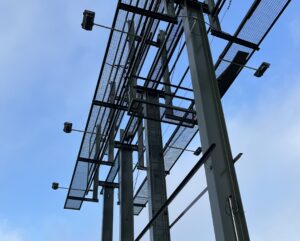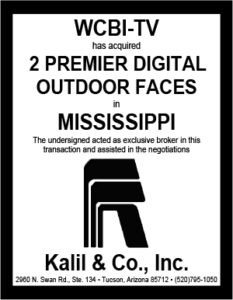Insider reached out to Jason Mallory, General Manager of Lindmark Steel on a recent rebuild project.
Jason, I hear you recently had an unusual rebuild project?
Yes, we recently rebuilt a pair of I- Beam structures for Lindmark Billboards, that were damaged by a severe downburst that hit Wichita Falls, Texas this past August.
The pair of builds fell into the unusual column for us, because we don’t build a lot of I-Beam structures anymore. Our customers almost exclusively purchase monopole units with pipe columns.

Can I assume your customer learned a storm lesson and approached the rebuild differently?
Yes and No. We would have to do a little research, but there is no telling how many severe storms this pair of structures have endured over their lifespans.
Any permitting issues related to the changes to the structure?
Only in that the two structures were legacy assets sitting on established permits, which limited us to a certain type of structure for the rebuild. In this case instead of rebuilding with a conventional monopole structure we were required to go back with four post I-Beam structures.

What was involved in the rebuild?
Lindmark Steel’s heritage comes from the Sign Company which has been around for nearly 60 years. While these two builds may have been first of their kind for most of our crew, our foreman’s have been a part of the company for 15 years or more and have completed similar builds in their careers. They have literally built them all. We recently rolled past our 10,500-work order. As a team, we had to dig a little deeper into our toolkits, and dust off some old techniques and re-learn some of our own history to get these built.
The first step was locating the I-Beams. We work with a handful of suppliers in the Fort Worth, TX. They had a few mills that could make the beams, but they were weeks from making a mill run. We ended up pushing the built nearly 2 months just waiting for the main support columns.
Next came the few modifications that were needed to get them prepared for installation. With conventional columns we can bring the material into the fabrication shop or the outside station and place it on a set of pipe rollers. But the shape of the I-Beams didn’t allow for this process, pushing 60 ft in length and 6,660 pounds, the 21 inch- 111 lb per foot beams were pushing the weight limits of welding tables as well.

Lastly came the installation process, with our conventional builds we usually drill and set columns, then assemble the heads nearby. This process starts with a torsion (head) pipe, then uprights, catwalks, and so on. This pair of I-Beam structures were designed without a standard torsion pipe, running across the tops of the support columns. Instead, each column was topped with a spreader beam, that is used to support the uprights. This creates four independent sign sections that are tied together laterally with the stringers, cat walks, and other lateral bracing. This design while not entirely uncommon for the era for which it was designed, brought about a unique challenge for our installation crews, because it required that the entire head section of the sign would have to be built in the air, using a crane and our service truck outfitted with a man basket on the boom.

How weatherproof is the rebuilt structure?
While we were limited to the type of structure we were allowed to re-install, the new structures were built in accordance with the current building codes for the city. Utilizing the same basic 4 post I -Beam design, in conjunction with new engineering brought our wind load up to 115 mph.
To receive a free morning newsletter with each day’s Billboard insider articles email info@billboardinsider.com with the word “Subscribe” in the title. Our newsletter is free and we don’t sell our subscriber list.
Paid Advertisement


















Excellent article.